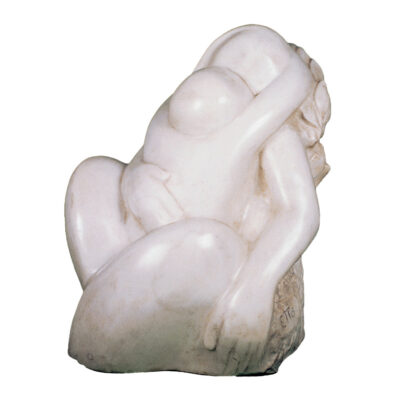A significant collection of works by Tuscan sculptor Ettò, donated to the Museum by the artist’s daughter, Sonia Pesetti, represents the key stages in his artistic production through an attentive selection of works representing the different periods and thematic cycles in the career of the artist, who was particularly talented at working with marble and stone and had an eye for figurative representation, though purged of realistic references, as well as abstract work. An imposing marble work inspired by the myth of Daphne is now on display in the Sculpture Garden.

Ettò (Ettore Pesetti)
BIOGRAPHY
Ettore Pesetti, per gli amici Ettò
(Pietrasanta 1903 – Milano 1987)
Ettore Pesetti, Ettò to his friends (Pietrasanta 1903 – Milan 1987) Ettore Pesetti, known as Ettò, was born in Pietrasanta, Lucca (Tuscany) in 1903.
A master sculptor highly specialised in working with hard materials such as marble and stone, Pesetti came from a family of artists and craftspeople: his father, Manfredo, was a sculptor and decorator who frequently worked abroad, his brother Giulio was a well-known and much-appreciated educator in Milan, and his brother Cesare was also a talented sculptor, who died in Belgium. At the age of only twelve, Ettò was already learning the “trade” in the studios of master sculptors in Pietrasanta, attending art school in the town in his youth. At the age of 24 he moved to Brussels to work with his father Manfredo and his older brother Cesare on a great monument to the unknown French soldier in Belgium at Desmaré. He spent a number of years here, which were to be very important for his professional and cultural development; it was at this time that he held his first major solo show in a well-known Brussels art gallery, Galerie Fievez.
Pesetti returned to Italy in the early Thirties and opened a studio of his own in Milan, where he met and spent time with a number of artists, most importantly Francesco Messina, Fausto Melotti and Eros Pellini. In the post-war years, and especially from the Sixties on, Ettò exhibited in group exhibitions and solo shows at the famous Galleria Barbaroux, on Milan’s Via Santo Spirito, near Via Montenapoleone. In the Eighties he set up a permanent exhibition of his work in his new studio in Milan and threw himself heart and soul into his work, often working with “direct cutting”. After his death in 1987, while working on a sculpture which was later named “Incompiuta” or “Incomplete”, two solo shows were held of his work: one in 1988 at Galleria Cortina in Milan’s central Piazza Cavour, and one marking the tenth anniversary of his death in 1997, held in Pietrasanta’s prestigious Sala delle Grasce, testifying to the artist’s strong ties with his native town.
Biographical information taken from the volume “ETTORE PESETTI (ETTO’) la scultura scolpita”, Cortina Arte Edizioni, Milan.





